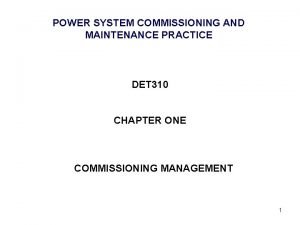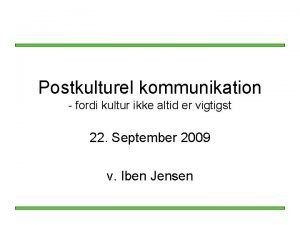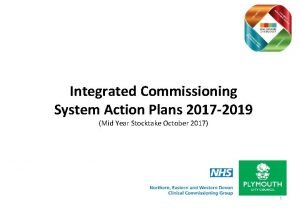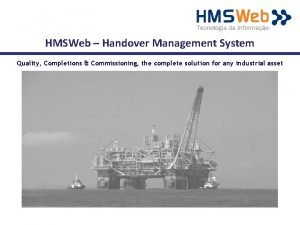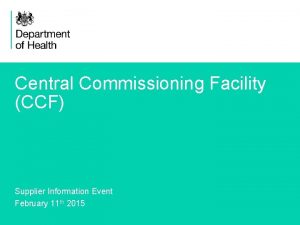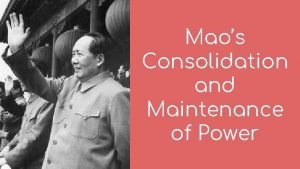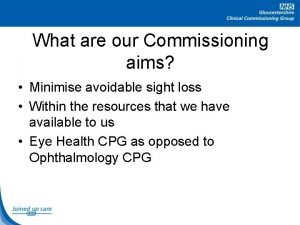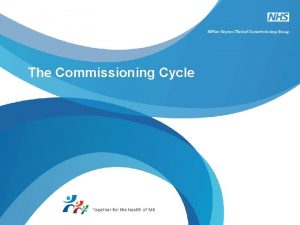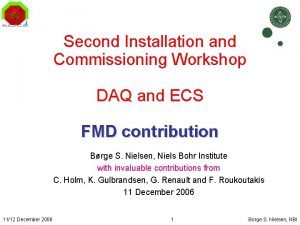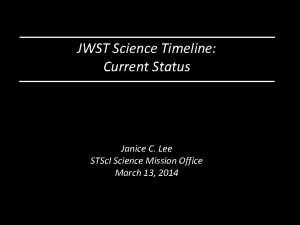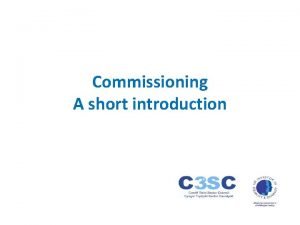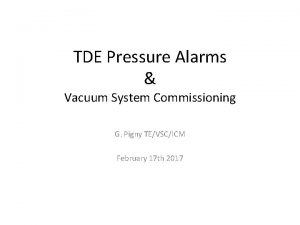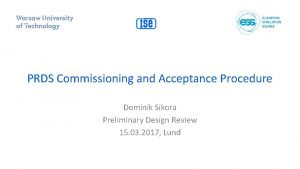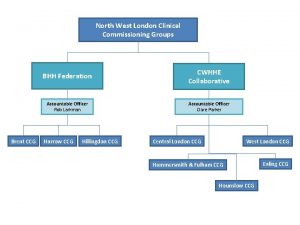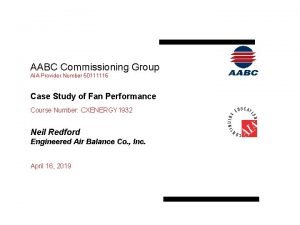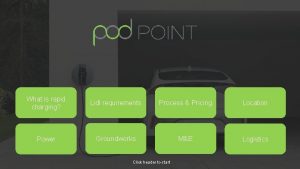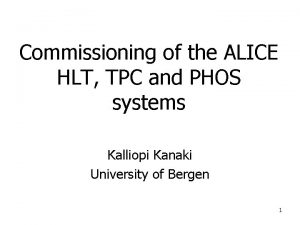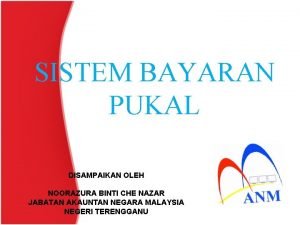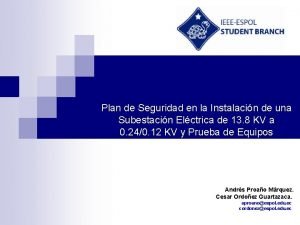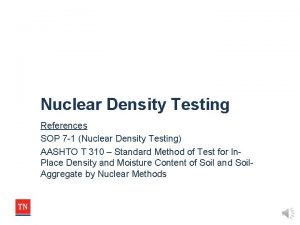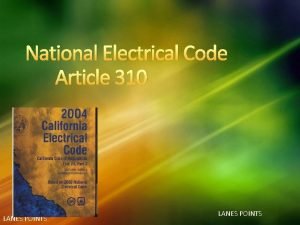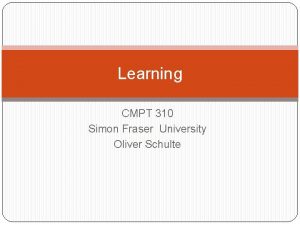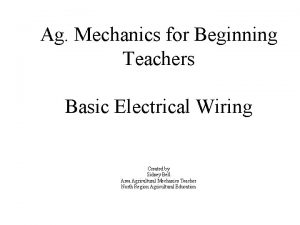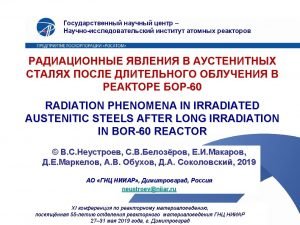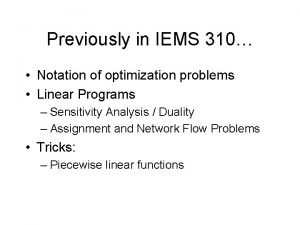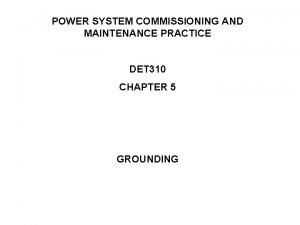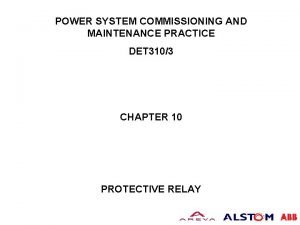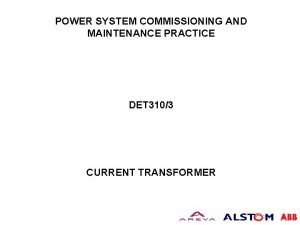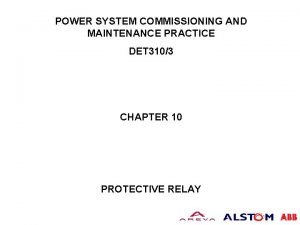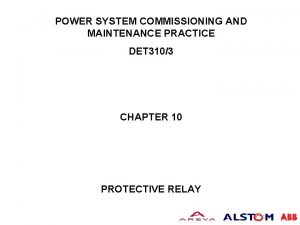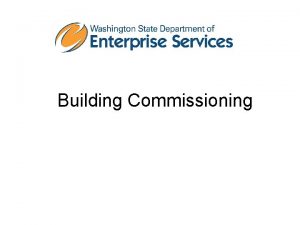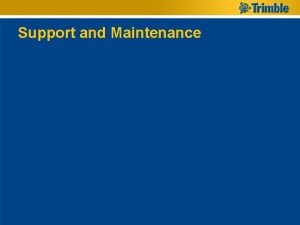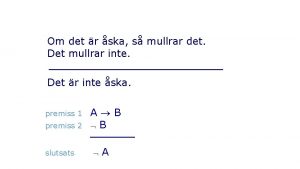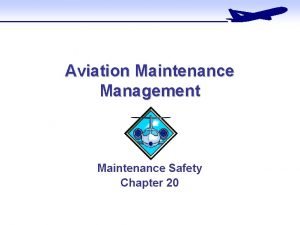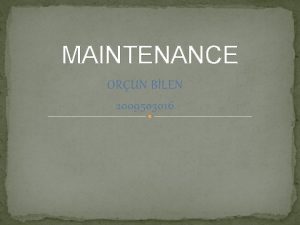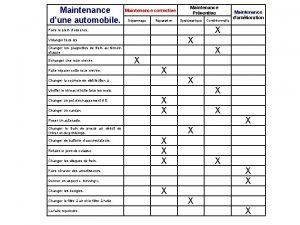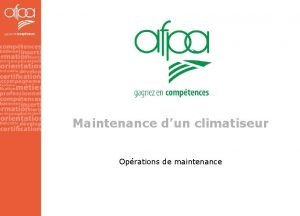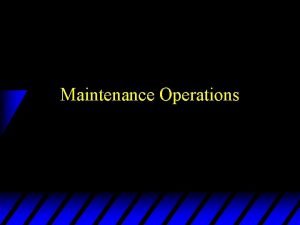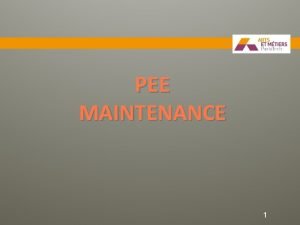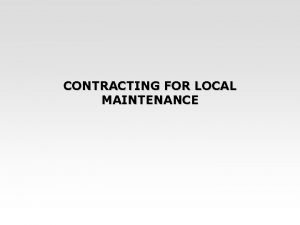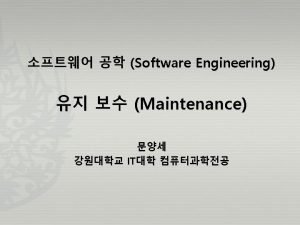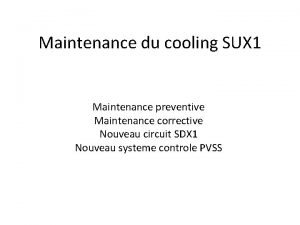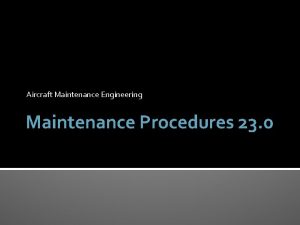POWER SYSTEM COMMISSIONING AND MAINTENANCE PRACTICE DET 310



































- Slides: 35

POWER SYSTEM COMMISSIONING AND MAINTENANCE PRACTICE DET 310 CHAPTER ONE COMMISSIONING MANAGEMENT 1

1. 0 INTRODUCTION The commissioning of electrical power systems may, in the first instance, be thought of a purely engineering activity, associated with understanding and proving the technical integrity, it is however, also a management process, requiring such qualities as; setting of objectives; planning; organising; documentation control; and, most important, the creation of team work. 2

1. 1 COMMISSIONING OBJECTIVES The objectives of commissioning is to prove that the individual items of equipment, which are interconnected to form systems, circuits and substations, are suitable for their intended purpose and acceptable for commercial service. 3

1. 1 COMMISSIONING OBJECTIVES (continue) This global objective can be subdivided into a) Verifying that the equipment has not been damaged in transit, that it has been properly installed, and performs as specified b) Obtaining test data as the basis for comparison with future maintenance and fault investigations results 4

1. 2 COMMISSIONING PROCESS PREPARE DESIGN SPECIFICATIONS (ESC) ISSUE TENDER DOCUMENT AND AWARD CONTRACT (ESC) OFF LOAD COMMISSIONING TEST (CONTRACTOR/ ESC) PRECOMMISIONING INSPECTION (CONTRACTOR/ ESC) PREENERGISATION INSPECTION (CONTRACTOR/ ESC) ON-LOAD COMMISSIONING TEST (CONTRACTOR/ ESC) MANUFACTURE EQUIPMENT (CONTRACTOR) ERECT EQUIPMENT ON SITE (CONTRACTOR/ ESC) POST COMMISSIONING INSPECTION (CONTRACTOR/ ESC) * ESC=electric Supply Company 5

1. 3 COMMISSIONING PROGRAM The commissioning program is the key activity to be progressed by the commissioning panel. It should ideally cover the following stages: 1. Pre-commissioning inspection 2. Off load commissioning test program 3. Pre-energised inspection 4. Energisation and on load commissioning tests (usually covered by the switching program) 5. Post commissioning inspection 6

1. 3 COMMISSIONING PROGRAMME (CONTINUE) i) Pre-commissioning inspection Inspection of installed equipment Objectives: To determined whether installation work is complete and satisfactory to the point where off-load commissioning tests can commence. 7

1. 3 COMMISSIONING PROGRAMME (CONTINUE) ii) Off load commissioning test Tests which are carried out with equipment disconnected from the power system Objectives: To prove the integrity of the installed equipment, hence its suitable for connection to the power system, by observing its performance under test conditions which, as far as practicable, simulate in service conditions and requirements. 8

1. 3 COMMISSIONING PROGRAMME (CONTINUE) Off load commissioning tests (continue): A program of test which include: Test associated with AC circuit diagram i) Test on current and voltage Transformer ii) Primary Injections Test associated with DC circuit diagram i) Secondary injection on DC relays ii) Circuit diagram logic tests 9

1. 3 COMMISSIONING PROGRAMME (CONT)COMMISSIONING MANAGEMENT Off load commissioning tests (continue): c) Equipment Secondary Injections d) Power Supplies i) 110 V battery and distribution board ii) 48 V battery and distribution board iii) Diesel Generator iv) low voltage AC supplies 10

COMMISSIONING MANAGEMENT 1. 3 COMMISSIONING PROGRAMME (CONT)Off load commissioning tests (continue): e) High Voltage equipment test i) Circuit Breaker v) Transformers ii) Switches vi) Reactors iii) Disconnectors vii) Busbars iv) Earth Switches viii) Cables 11

f) Common Equipment i) Busbar Protection ii) Interlocking iii) Synchronizing iv) air system v) Substation Control Systems g) Earthing System i) Substation earthing mat ii) interconnection of earthing system iii) Tower earthing 12

COMMISSIONING MANAGEMENT h) High-voltage pressure Test i) Auto-switching off-load simulation tests j) End to end Test i) Power Line Carier ii) Intertripping iii) Protection System iv) Substation Control System k) Insulation resistance Test associated with the above 13

COMMISSIONING MANAGEMENT 1. 3 COMMISSIONING PROGRAMME (CONTINUE) iii) On-Load Commissioning Tests which are carried out with the equipment connected to the power system. Objectives: This test utilized the power system itself to demonstrate that the installation is technically acceptable for commercial operation 14

COMMISSIONING MANAGEMENT 1. 3 COMMISSIONING PROGRAMME (CONTINUE) iv) Pre-energisation Inpection: Process which are carried out before the circuit being energised Objectives: To ensure that all equipment are properly connected and in proper condition before energisation 15

1. 3 COMMISSIONING PROGRAMME (CONTINUE) Example: a) Confirmation of circuit nomenclature b) Confirmation that equipment phase connections are in accordance with the phasing diagram c) Application of locks d) Checking the correct position of all valves e) Ensuring satisfactory indication of all pressure valves f) Checking that all equipment is satisfactorily earthed 16

COMMISSIONING MANAGEMENT 1. 3 COMMISSIONING PROGRAMME (CONTINUE) g) Ensuring the satisfactory conditioned of all battery supplies h) Checking that all test connections have been removed i) Confirmation of the tightness of all terminations j) Confirmation that all current transformers are normal k) Confirmation that all current transformers links are normal l) All relay settings have been applied correctly m) Confirmation that all commissioning documentation is completed. 17

1. 3 COMMISSIONING PROGRAMME (CONTINUE) v) Post Commissioning Inspection: Process which are carried out after circuit/system has been energised Objectives: To ensure and recheck that the equipments have been left in the service condition 18

1. 3 COMMISSIONING PROGRAMME (CONTINUE) COMMISSIONING MANAGEMENT Post commissioning inspection (continue)Example: i) Ensuring that all temporary commissioning equipment has been removed. ii) Ensuring that all current transformers links are normal iii) Checking the correct position of all IN/OUT switches and transformers tap position iv) Ensuring that all relay settings are normal v) General visual inspection vi) Ensuring that all commissioned equipment are clearly identify 19

1. 4 COMMISIONING PANEL The commissioning panel is responsible for managing the whole commissioning process. The commissioning panel typically consists of the following representation: a) Chairman, usually project manager b) Technical engineer from the supply company capable of defining the required tests and accepting the test results. c) Contractor representatives d) supply company power system operations department (mainly concerned with the energisation process) e) representatives of any companies whose equipment 20 interfaces with that being commissioned.

1. 4. 1 Commissioning-panel Agenda Typical format and subject matter for an agenda is as follows: a) Project title b) Circuits and substation involved c) Commissioning panel membership d) Scope: at this stage all members of the commissioning panel should be fully apprised of the extend of the works. To assists this process the activities may be categorised into: i) civil works ii) high-voltage equipment iii) low-voltage equipment iv) protection and control system 21

1. 4. 1 Commissioning Panel Agenda (continue) v) substation control system including interconnection with control centers. vi) metering vii) DC and AC power supplies viii) telecommunications equipment. 22

1. 5 DOCUMENTATION An essential requirement of the commissioning process is the formal documentation on both the management activities and the commissioning test. Two type of documentation are a) Commissioning report- The commissioning report is the formal record of the managerial process. It should consists of 23

1. 5 DOCUMENTATION (CONT)- i) A contents sheet, updated as the project progress ii) A copy of high level design specifications iii) Formal minutes of commissioning meetings iv) The programmed of work to be carried out, showing planned and actual completion dates v) A schedule of commissioning test vi) A commissioning completion documentation, to certify that all work is completed. 24

1. 5 DOCUMENTATION (CONTINUE)b) Commissioning Log Is the record of the technical process, comprising the complete commissioning test schedule, test certificates, inspection report, switching programme and other relevant technical document 25

1. 5. 1 Sub-station Documents: Test Certificates: Very important documents as they are record of the work carried out. Test certificates should be completed upon completion of testing. It should contain customer acknowledgement whom witnesses the test, which is immediately after the test is completed. 26

1. 5. 1 Sub-station Documents (Cont)Schematic Drawings: Represent the electrical as a whole with regard to protection, control and monitoring schemes. Two (2) sets of drawing normally given for the testing and commissioning work. i) One set is used as a working copy ii) One set for the sub-station and to be kept in the stations at all time. Green color pen should be used to mark the checked circuit on the working copy of the drawing. 27

1. 5. 1 Sub-station Documents (continue-) Any necessary modification of the drawing should be made by red color pen. Upon completion of the testing and commissioning work, the commissioning copy of the circuit drawing to be handed over to the customer. Cable Schedules: A lists down the multi-core cables that are used in the substation- cable size, no of cores, marking no and points of termination. Any changes in the cable termination should be updated in the cable schedule by red pen. Termination list should agree with the circuit drawing. 28

1. 5. 1 Sub-station Documents (continue-) Upon completion of the testing and commissioning work, the cable list to be handed over to the customer. Operation and Maintenance manual: Each type of equipment must be ensured to have operating and maintenance manual. Relay Settings Document: A record of all relays’ final setting. The final lists settings shall be given to the customer upon completion. 29

1. 5. 1 Sub-station Documents (continue-) Other Documents: Any outstanding, defects or irregularities are to made aware to the main contractor and documented for the record. Any correspondence regarding to above matters must have reference number form the office and copies to be given and kept in the office. All important documents from customer to be kept for record. 30

1. 5. 2 Drawing Control During design, manufacture and installation inspection system must give up to date, precise and detail records of all activities. Design documents are issued with various categorizations depending upon level of approval Revision Status Comments A PRE/VLO Initial preliminary design doc. (after normal internal drawing) B VLA VLO has been circulated within the organization internally and modified if necessary to incorporate any additional comments. E DES/APR ‘Descriptive’ or ‘Approve’ status document which has gone through the VLO and VLA status check. 1 EXN ‘Execution or drawing’ status doc which has gone through the VLO and VLA status checks and released to site or sjhop floor for execution. 4 ASB ‘As Built’ status doc or drawing that has been issued that it incorporates any site or shop floor modifications that have taken place during commissioning 31

COMMISSIONING MANAGEMENT 1. 6 COMMISSIONING CERTIFICATES a) Acceptance Certificate This certificate declares that i) The equipment is ready to be connected to the power system ii) The equipment has been energised and subject to on-load commissioning tests b) Contract Taking Over certificate When the work has been completed satisfactorily and the equipment commissionied, a contract taking-over certificate or similar documents will require completion. This document notifies the contractor that the supply company 32 has accepted and that the warranty period has commence.

1. 7 COMMISSIONING PRACTICE COMMISSIONING MANAGEMENT The following activities are items of good commissioning practice: Philosophy: Take nothing for granted. Periodically reflect on what to be done, what might have been missed, what might alternately be done. Employ lateral thinking. Assume everything is wrong until proven otherwise. 33

COMMISSIONING MANAGEMENT 1. 7 COMMISSIONING PRACTICE (continue-) Extend of Testing: Proof of the satisfactory working of items of equipment and their interconnecting circuitry is required. Equipment test should not replicate comprehensive factory test but must be minimum to verify satisfactory installation. Protection/measuring equipment should be tested at the proposed setting range and be within 5% range. 34

COMMISSIONING MANAGEMENT 1. 7 COMMISSIONING PRACTICE (continue-) Formality: Commissioning requires formality to create a more discipline thoughtful and professional approach. It identifies accountability and creates a clear and auditable record of activities for future reference. Advance prediction of Results: a professional approached to testing requires that the results are predicted in advance of the test. 35
 Power system commissioning
Power system commissioning Det beskrivende kulturbegreb
Det beskrivende kulturbegreb Fatimas hand haram
Fatimas hand haram Integrated commissioning and progress system
Integrated commissioning and progress system Human and physical features
Human and physical features Central commissioning facility research management system
Central commissioning facility research management system Draw the power triangle
Draw the power triangle Preventive and predictive maintenance of hydro power plant
Preventive and predictive maintenance of hydro power plant Mao consolidation and maintenance of power
Mao consolidation and maintenance of power Commissioning cycle
Commissioning cycle Aecp requirements
Aecp requirements Steps
Steps Ecs commissioning
Ecs commissioning Heat pump balance point
Heat pump balance point Scientist project
Scientist project Commissioning cycle
Commissioning cycle Value based commissioning
Value based commissioning Vacuum systems commissioning
Vacuum systems commissioning Dominik sikora
Dominik sikora North west london ccg
North west london ccg Commissioning
Commissioning Aabc commissioning group
Aabc commissioning group Pod point commissioning
Pod point commissioning Croydon clinical commissioning group
Croydon clinical commissioning group Ecs commissioning
Ecs commissioning Power angle curve in power system stability
Power angle curve in power system stability Bayaran pukal meaning
Bayaran pukal meaning Falla trifasica
Falla trifasica 310 huey p long
310 huey p long Aashto t 310
Aashto t 310 310 16 table
310 16 table Cmpt 310
Cmpt 310 Split duplex receptacle symbol
Split duplex receptacle symbol Cyclemys dentata
Cyclemys dentata 3-5/310
3-5/310 Iems 310
Iems 310
